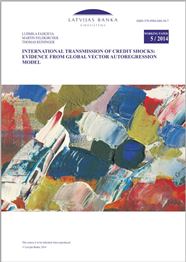International Transmission of Credit Shocks: Evidence from Global Vector Autoregression Model
 5/2014
5/2014
Abstract: In this paper, we examine international transmission of the negative credit supply shock, which originated in the euro area and the US. We use the multi-country global vector autoregression (GVAR) approach with trade and bilateral banking exposures as weights, and identify five structural shocks via sign restrictions. Special focus of this research is on CESEE – a region that shares strong financial linkages with the euro area. Our main results are as follows. First, US-specific shocks account for a significant share in explaining the deviations from growth trends in output and total credit in both the euro area and the US; second, compared to a domestic aggregate demand shock, the economic downturn caused by the credit supply shock in the US and the euro area can bring more harm in the long run, yet the international spillover of the former is stronger; third, the transmission of euro area shocks to emerging Europe is faster and more pronounced compared to US shocks; fourth, there is strong heterogeneity in responses of emerging Europe to shocks in the euro area and the US.
Keywords: credit shock, global vector autoregressions, sign restrictions
JEL codes: C32, F44, E32, O54
Textual error
«… …»

